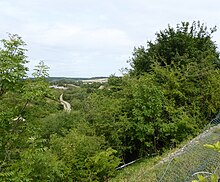| Site of Special Scientific Interest | |
 | |
| Location | Suffolk |
|---|---|
| Grid reference | TM 115 499[1] |
| Interest | Geological |
| Area | 2.2 hectares[1] |
| Notification | 1992[1] |
| Location map | Magic Map |
Great Blakenham Pit is a 2.2-hectare (5.4-acre) geological Site of Special Scientific Interest south of Great Blakenham in Suffolk.[1][2] It is a Geological Conservation Review site.[3]
This is described by Natural England as a key site for Pleistocene studies. It has a sequence of early and middle Pleistocene deposits, including from the ancient course of the River Thames through East Anglia and from the severe Anglian ice age.[4]
The site is private property with no public access.
References
[edit]- ^ a b c d "Designated Sites View: Great Blakenham Pit". Sites of Special Scientific Interest. Natural England. Retrieved 30 July 2017.
- ^ "Map of Great Blakenham Pit". Sites of Special Scientific Interest. Natural England. Retrieved 30 July 2017.
- ^ "Great Blakenham (Quaternary of East Anglia)". Geological Conservation Review. Joint Nature Conservation Committee. Retrieved 30 July 2017.
- ^ "Great Blakenham Pit citation" (PDF). Sites of Special Scientific Interest. Natural England. Archived from the original (PDF) on 4 May 2015. Retrieved 30 July 2017.
Well, that’s interesting to know that Psilotum nudum are known as whisk ferns. Psilotum nudum is the commoner species of the two. While the P. flaccidum is a rare species and is found in the tropical islands. Both the species are usually epiphytic in habit and grow upon tree ferns. These species may also be terrestrial and grow in humus or in the crevices of the rocks.
View the detailed Guide of Psilotum nudum: Detailed Study Of Psilotum Nudum (Whisk Fern), Classification, Anatomy, Reproduction